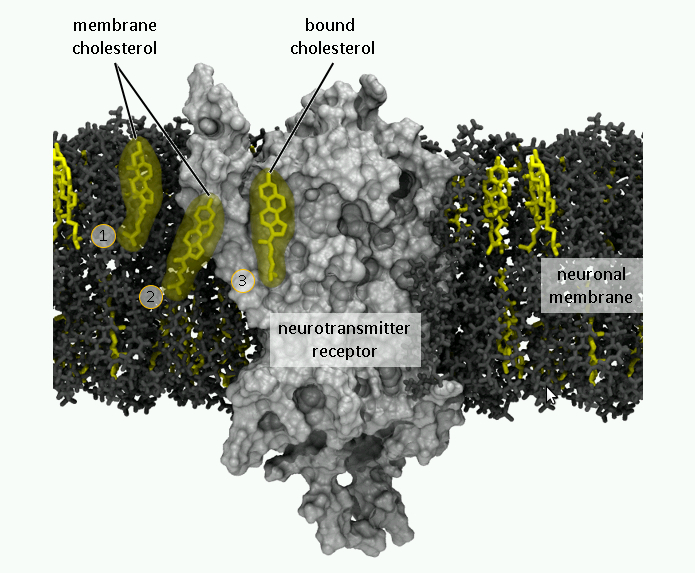
09/09/2021 - General information
Researchers from the Hospital del Mar Medical Research Institute (IMIM) have discovered a novel mechanism through which the serotonin receptor interacts with cell membranes in the human brain. This finding opens the door for the design of novel drugs, which could treat central nervous system disorders.
A study lead by researchers from the Hospital del Mar Medical Research Institute (IMIM) and the Centre for Cellular and Molecular Biology of the Council Of Scientific And Industrial Research (CSIR) published in the Science Advances journal, shows for the first time how cholesterol can interfere with the function of a important receptor present in brain cells - the serotonin receptor. This finding is of great importance, as it allows to devise new ways to modulate those receptors, which in the future could lead to the development of new drugs to treat diseases of the central nervous system.
Cholesterol is an essential component of the neuron membrane. Multiple proteins reside within those membranes, including GPCRs (G-protein coupled receptors). GPCRs are a large receptor family, encompassing serotonin receptors, which act as cellular receptors, detecting outside signals and transmitting towards the cell. Because of this, GPCRs are crucial for correct communications between cells. Those receptors are involved in the most important physiological processes, for example allowing us to perceive sensory stimuli, like vision, taste or smell. Furthermore, they play an important part in immunological events, the modulation of behavior, as well as other crucial processes in the human body.

An explanatory image showing the pathway of cholesterol from the membrane into the discovered binding site on the neurotransmitter receptor. Source:IMIM.
In this study, researchers from IMIM demonstrate, for the first time, how cholesterol influences the function of serotonin receptors at an atomic scale. This finding describes the structural basis of a yet undescribed cross-talk between those receptors and the membrane. "Until know it was not clear how the presence of cholesterol influences the behavior of those proteins, due to the lack of methods that can capture the dynamics of such biological events at an atomic scale" explains Dr Jana Selent, the head of the GPCR Drug Discovery Group, and the co-supervisor of the study. "The results of our study show the intimate relation between cholesterol and GPCRs of the central nervous system and highlight the key role of this molecule in signal transmission within the brain" she adds. "Our findings pave the path for novel lines of investigation, like the use of membrane components as tools to treat disorders of the central nervous system"
To paraphrase, "using state-of-the-art molecular simulations we have detected how cholesterol explores the surface of the serotonin 1A receptor, until it finds a specific structural motif. Once cholesterol tightly binds, it is able to modulate the structural dynamics of the receptor, which leads to a specific transmission of cellular signals by the receptor", highlights Dr. Selent. In collaboration with Dr. Amitabha Chattopadhyay, from the Center for Cellular and Molecular Biology in New Delhi, it was possible to design an experimental protocol that showed the key function of this motif, in mediating the effect of cholesterol on a cellular level.
"The levels of cholesterol in cell membranes can have a much more direct effect than previously thought on the behaviour of proteins crucial in the development and progression of central nervous system disorders. For example these findings could help find a link between altered levels of membrane cholesterol, observed in patients with schizophrenia, and some of the symptoms observed in this disorder", explains dr Tomasz Stepniewski, a post-doc in IMIM and the co-author of the article. "Although further work is necessary to better understand the relation between GPCRs and cholesterol in the membrane, this study provides a framework to design novel molecules which could modulate this important group of membrane proteins".
Article of reference
G. A. Kumar, P. Sarkar, T. M. Stepniewski**, M. Jafurulla, S. P. Singh, J. Selent*, A. Chattopadhyay*. A molecular sensor for cholesterol in the human serotonin1A receptor. Sci. Adv. 2021, 7, eabh2922
*corresponding author
**co-first author
Servei de Comunicació:
Marta Calsina(ELIMINAR)
Tel:
(+34) 93 316 06 80
Doctor Aiguader, 88
08226 Barcelona
© Institut Hospital del Mar
d'Investigacions MèdiquesLegal Notice and Privacy Policy | Cookie Policy | Site Index | Accessibility | Find Us | Contact